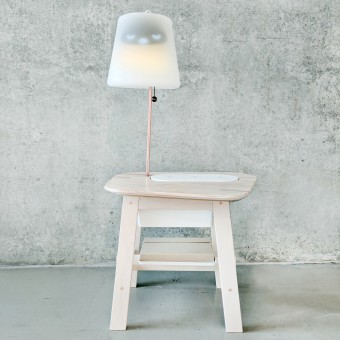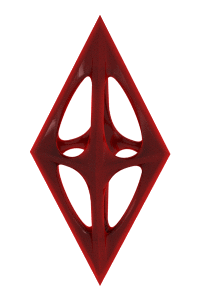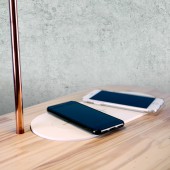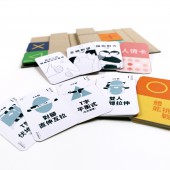Lamb Interactive playful lamp by Brian Lee and Benny Leong |
Home > Winners > #64928 |
 |
|
||||
| DESIGN DETAILS | |||||
| DESIGN NAME: Lamb PRIMARY FUNCTION: Interactive playful lamp INSPIRATION: The design was inspired by a particular family based counselling service offered by our client and collaborator, the Integrated Centre on Addiction Prevention and Treatment of Tung Wah Group of Hospitals in Hong Kong, which encouraged the design team to push forward a novel family focused intervention strategy for enhancing intimate parent and adolescent interactivity through specifically designed tangible games to mitigate excessive use of mobile phone by adolescents. UNIQUE PROPERTIES / PROJECT DESCRIPTION: First of its kind in Hong Kong that multidisciplinary professions in exploring alternative practices to mitigate mobile phone overuse of adolescents by family functioning and gamification theory, a play platform as well as an interactive lamp is designed to enhance parent and adolescent interactivity at home. We identified positive benefits that physical collective playing not only stimulated emotional connectivity between parents and adolescents but also encouraged them to relive joyful memories of family activities before the mobile overuse problem had arisen. OPERATION / FLOW / INTERACTION: Family members are encouraged to rest their phones on the play platform for charging. The lamp will be awoken by the first mobile to land on its charger. When all phones of members are placed on the charger, the lamp brightened further, showing a smiling expression, and invited the family to play. When a hand waved over the sensor of the lamp, it will suggest games randomly via its LED display. Players can then open the gamebook and draw a card randomly from within the stack suggested by the lamp. Various competitive games with specific time constraints are available. PROJECT DURATION AND LOCATION: The project has been commenced since Jan 2016 in Hong Kong. The research work was presented at the 1st Asia Pacific Conference for Addiction Professionals on the Application of the Syndrome Model and the Asia Design Engineering Workshop respectively in May and December 2017. Ongoing development is being prepared to refine the prototype and extend the research work with the Integrated Centre on Addiction Prevention and Treatment of Tung Wah Group of Hospitals in Hong Kong in 2018-19. |
PRODUCTION / REALIZATION TECHNOLOGY: The play platform contains four major parts: (i) the table, which assembled mainly by ready made components including a mobile charger, a wooden framework, a plastic container, and a vibration activated timer; (ii) the lamp, which integrates a bulb, LED display, motion sensor and Bluetooth module into a 3D printed housing to provide random game play instruction; (iii) the game card book where six stacks of competitive games (for physical competence and intellectual challenges) are kept to be randomly suggested; and (iv) the gaming record book and the operation manual of the lamp. SPECIFICATIONS / TECHNICAL PROPERTIES: Overall dimension: 520mm x 400mm x 1030mm Power supply: 220-240V Output inductive charging: 3 x 5W Light bulb output: Max. 13W TAGS: Mobile phone overuse, Research through design, Family functioning, gamification enhanced intervention, Parents and adolescent relationship RESEARCH ABSTRACT: Can collective play enhance cohesiveness of parent and adolescent relationships associated with excessive mobile phone use? Based on the family functioning and gamification theory, this project explores a family focused intervention strategy to verify the assumption that collective play activities can impact positively on parent and adolescent relationships, in return enhancing the psychosocial role of family in mitigating likelihood of addiction development of adolescents. With data collected and evaluated with various families, initial results apparently assured the benefits of this gamification enhanced intervention in a family context. CHALLENGE: The challenge faced by the research team was threefold: firstly, seeking for ideal, yet appropriate formats of play and types of physical games which could stimulate affective involvement and responses of parents and adolescents; secondly, recruiting families which could spare time on testing the play platform and filling in a series of self reporting home assignments corresponding to their collective play preferences and experiences; and lastly, enabling economic and efficient batch production of the play platforms and games cards for responsive deployment and ease of upgrade. ADDED DATE: 2018-02-23 11:12:29 TEAM MEMBERS (7) : Project Director: Benny Leong, Design Director: Brian Lee, Interaction Design Consultant: Dr. Kenny Chow, ICAPT Counsellor: Dr. Elda Chan, Product Designer: Ada Chan, Engineer: John Mak and Production Consultant: Industrial Centre, The Hong Kong Polytechnic University IMAGE CREDITS: Image #1 to #5: Brian Lee/ Benny Leung/ Ada Chan Video Credits: Jack Yeung |
||||
| Visit the following page to learn more: http://www.sd.polyu.edu.hk/en/research/d |
|||||
| AWARD DETAILS | |
 |
Lamb Interactive Playful Lamp by Brian Lee and Benny Leong is Winner in Lighting Products and Fixtures Design Category, 2017 - 2018.· Read the interview with designer Brian Lee and Benny Leong for design Lamb here.· Press Members: Login or Register to request an exclusive interview with Brian Lee and Benny Leong. · Click here to register inorder to view the profile and other works by Brian Lee and Benny Leong. |
| SOCIAL |
| + Add to Likes / Favorites | Send to My Email | Comment | Testimonials | View Press-Release | Press Kit |
Did you like Brian Lee and Benny Leong's Lighting Design?
You will most likely enjoy other award winning lighting design as well.
Click here to view more Award Winning Lighting Design.








